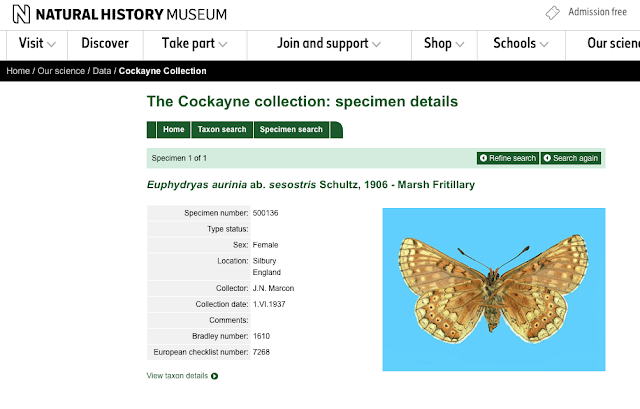In my article on Colonel Valentine Burkhardt and his entomological activities in the south of England during the 1940s, I referred to an article by the Reverend John Neville Marcon (1903-1906). Marcon was clearly a avid collector of ‘aberrant’ forms of British butterflies, spending hours and hours in the field. In an article, Reminiscences of a Butterfly Hunter, published in The Entomologist’s Record and Journal of Variation in 1975, he explained:
I began collecting enthusiastically in 1921. It soon became clear that the time was not available for butterflies and moths. If in 50 odd years I was fortunate in securing a fairish number of aberrations it must largely be attributed to the "luck of the game", an urge to explore adjacent territory and a determination to persist once a good butterfly had been spotted come what may—characteristics which are commonplace with every serious bug-hunter. On one occasion an insect (a melanic male Argynnis paphia L.[Silver-washed Fritillary]) took eight hours to catch—three of one day, five of the next. Another time it was 2 days of unremitting search after a prize had been sighted (a black forewing female adippe [High Brown Fritillary]) before it was safely inside a pill-box.
But it was how he eventually caught his black forewing female adippe, that the eye is drawn to in the next sentence:
What revealed it was a doodle-bug exploding in the next field, which lifted me off the ground as I was lying flat: but the displacement of air had a satisfying effect, for within ten yards there was the treasure I had been searching for so long.
A doodle-bug was the German V-1 flying bomb. Although these were aimed to run out of fuel and explode on impact in London—and many did, with devastating effect, British intelligence was using double agents to fool the enemy into believing bombs that had landed on London had overshot the target. The range of the V1 was shortened and as a result many landed in the relatively uninhabited counties south of London. Was it one of these that lifted Marcon off the ground?
 |
| This specimen of the Marsh Fritillary collected by Marcon in 1937 is in the British Natural History Museum |
As Marcon's grandson, great to see this, particularly as I'm using his desk to view it, complete with measuring circles!
ReplyDelete